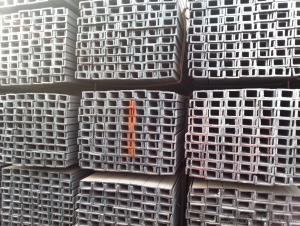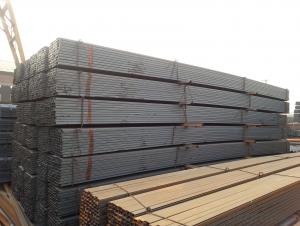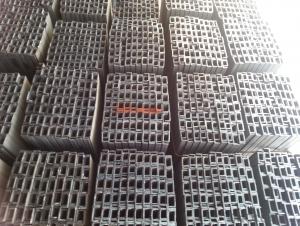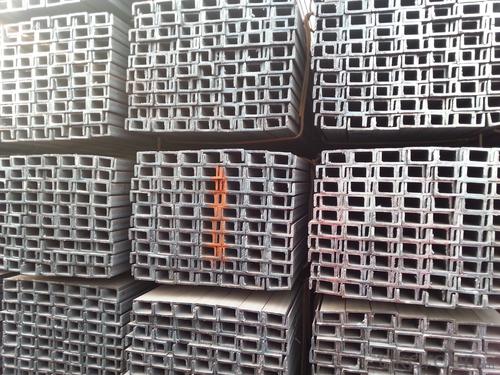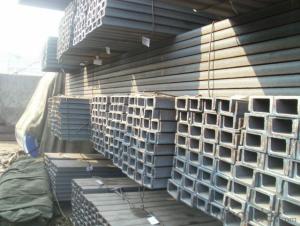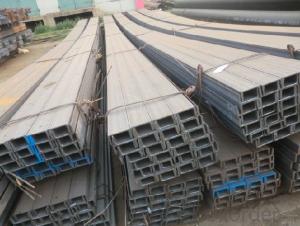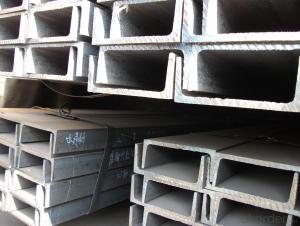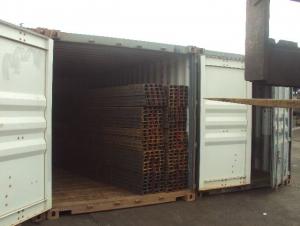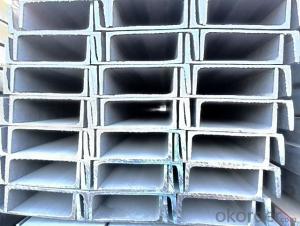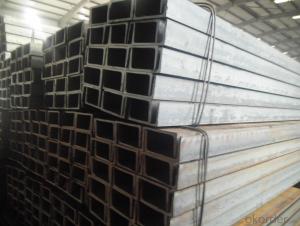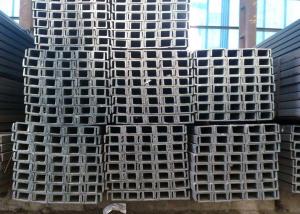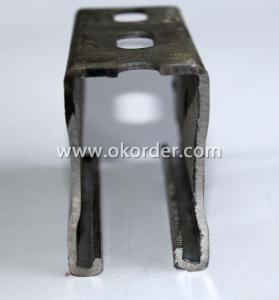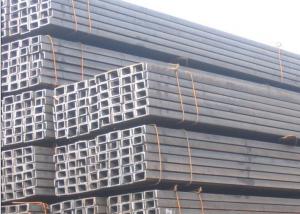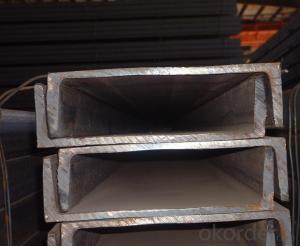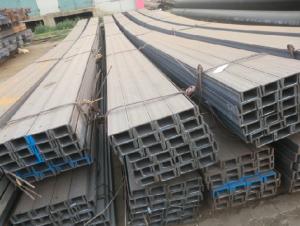JIS Standard U Channel
- Loading Port:
- China Main Port
- Payment Terms:
- TT or LC
- Min Order Qty:
- -
- Supply Capability:
- -
OKorder Service Pledge
OKorder Financial Service
You Might Also Like
Product Description:
OKorder is offering high quality Channel Steel at great prices with worldwide shipping. Our supplier is a world-class manufacturer of steel, with our products utilized the world over. OKorder annually supplies products to European, North American and Asian markets. We provide quotations within 24 hours of receiving an inquiry and guarantee competitive prices.
Product Applications:
Channel Steel is usually used for building structure, vehicle manufacturing and other industrial structure and often used with i beam.
In details, the channel steel belongs to carbon structural steel which is applied to in the field of construction and machinery. The channel steel is usually used for arch-itechtural structure, and they could be welded in order to support or hang a vari-ety of facilities. They are also usually used in combination with I beam. Generally,the channel steel must possess perfect welding property, riveting property and mechanical property and so on.
Product Advantages:
OKorder's Channel Steel are durable, strong, and resist corrosion.
Main Product Features:
· Premium quality
· Prompt delivery & seaworthy packing (30 days after receiving deposit)
· Corrosion resistance
· Can be recycled and reused
· Mill test certification
· Professional Service
· Competitive pricing
Product Specifications:
| Original Place | Tangshan, China | Brand Name | Bridge |
| Standard | GB707-88, EN100025, JIS G3192, DIN 1026 | ||
| Sizes | 50mm to 300mm | ||
| Sales Volume/Year | 3000MT | ||
| Main Market | Middle East, Africa, Southeast As | ||
1.We are able to provide channel steel of top quality at attractive price.
2.Our products of channel steel have passed ISO9001:2008 Quality Management System Certification.
Package & Delivery of Channel Steel:
The steel u channel will be packed in bundle with steel wire at each end of every bundle and color marking in order to help the customer to recognize his goods more easily at sight.
And steel u channel could be loaded into 20ft or 40ft container, or by bulk cargo. If the weight of each bundle reaches less than 3.5 mt, the loading by break bulk cargo should be choosed. When the weight of each bundle reaches less than 3mt, the loading by container should be choosed.
As for the transportaion from mill to loading port, the truck will be usually used. And the maximum quantity for each truck is 40mt.
All in all, we could do in accordance with customer's request.
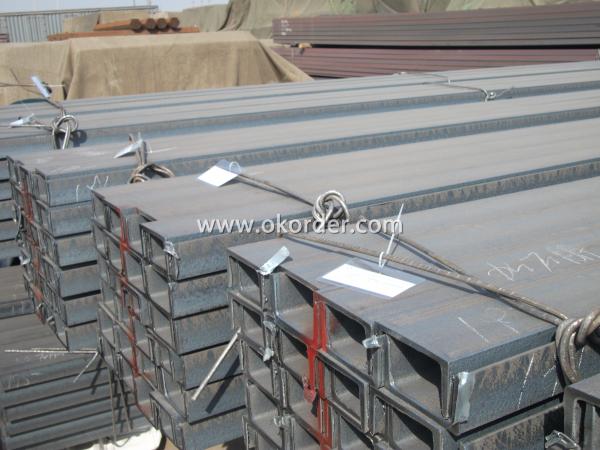
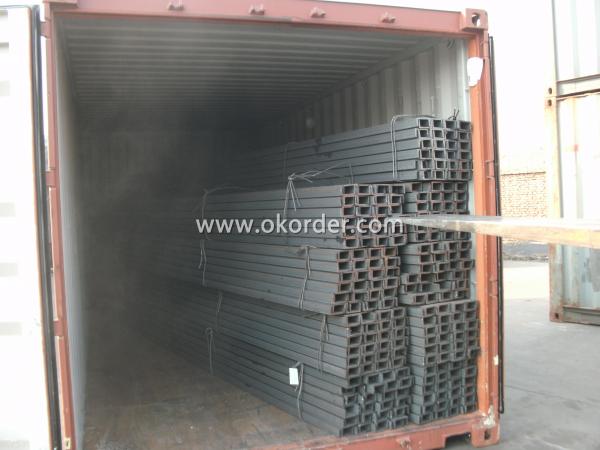
Production Flow of Channel Steel:
1.The steel billet shall be heated in the high temperature furnace.
2. The heated steel billet shall be rolled five to nine times with the aim of shaping the general figure of steel u channel.
3. The rolled steel u channel should be put onto the cooling bed to make the temperature low.
4. The steel u channel should be straighted on the straightener.
5. The straighted steel u channel will be cut into meters by saw, as per customer's requirements.
FAQ:
Q1: Why buy Materials & Equipment from OKorder.com?
A1: All products offered byOKorder.com are carefully selected from China's most reliable manufacturing enterprises. Through its ISO certifications, OKorder.com adheres to the highest standards and a commitment to supply chain safety and customer satisfaction.
Q2: How do we guarantee the quality of our products?
A2: We have established an advanced quality management system which conducts strict quality tests at every step, from raw materials to the final product. At the same time, we provide extensive follow-up service assurances as required.
Q3: How soon can we receive the product after purchase?
A3: Within three days of placing an order, we will begin production. The specific shipping date is dependent upon international and government factors, but is typically 7 to 10 workdays.
- Q: Are steel channels suitable for use in agricultural structures?
- Agricultural structures can indeed make use of steel channels. Steel itself is a robust and enduring material, capable of enduring the often harsh environmental conditions that are typically present in agricultural settings. Not only is it resistant to pests, rot, and decay, but it also offers a long-lasting solution for constructing buildings such as barns, storage sheds, and livestock shelters. Steel channels prove particularly advantageous in agricultural structures, as they not only provide essential structural support but can also be effortlessly incorporated into the building's design. Moreover, steel possesses fire-resistant properties, a critical aspect to consider when handling the flammable materials commonly found on farms. Ultimately, the utilization of steel channels in agricultural structures ensures stability, durability, and safety.
- Q: How do steel channels compare to other types of steel profiles?
- When comparing steel channels to other steel profiles, it becomes evident that they possess numerous benefits. Firstly, their high strength and durability are widely recognized. Due to their U-shaped design, steel channels can effectively bear heavy loads without succumbing to bending or warping, making them ideal for structural purposes. Additionally, this strength enables them to withstand extreme weather conditions and external forces, ensuring their longevity. Secondly, steel channels offer exceptional versatility. They can be easily customized and fabricated to meet specific project requirements, making them suitable for a variety of applications, including structural support, framing, and reinforcement. Furthermore, steel channels are available in various sizes and thicknesses, allowing them to be utilized in projects of different scales. Moreover, steel channels exhibit remarkable corrosion resistance. Typically crafted from carbon or stainless steel, which both possess natural anti-corrosion properties, they are well-suited for outdoor and marine environments that are prone to moisture or chemical exposure. Furthermore, steel channels are cost-effective. Being widely available and abundant, steel is relatively affordable compared to other construction materials. Additionally, the durability and longevity of steel channels result in reduced maintenance costs over time, making them a cost-efficient choice for many applications. Lastly, steel channels offer ease of installation. Their uniform shape and standardized dimensions make them simple to work with, thereby reducing installation time and labor costs. This ease of installation also makes steel channels the preferred choice for DIY projects or small-scale constructions. In conclusion, steel channels possess numerous advantages over other steel profiles. Their strength, versatility, corrosion resistance, cost-effectiveness, and ease of installation make them a popular choice for various construction projects.
- Q: How do steel channels contribute to energy-efficient lighting design?
- Steel channels contribute to energy-efficient lighting design in several ways. Firstly, steel channels are commonly used to create efficient lighting fixtures such as linear LED light fixtures. These fixtures are designed to maximize the distribution of light, ensuring that a significant portion of the emitted light is directed towards the intended area. By using steel channels to create these fixtures, the light can be directed in a controlled and efficient manner, reducing the amount of wasted light and increasing the overall efficiency of the lighting system. Secondly, steel channels can be used to mount and position lighting fixtures in a way that optimizes their effectiveness. By using steel channels, lighting fixtures can be easily adjusted and positioned to direct light precisely where it is needed, minimizing any unnecessary spillage and improving the overall lighting efficiency. This allows for better illumination of specific areas while reducing light pollution and unnecessary energy consumption. Furthermore, steel channels can also be utilized to improve the thermal management of lighting systems. LED lights generate less heat compared to traditional lighting sources, but they still require proper cooling to maintain their efficiency and longevity. Steel channels can be designed to dissipate heat efficiently, acting as a heat sink for the lighting fixtures. By effectively managing the heat generated by the lighting system, the overall energy efficiency of the lighting design is enhanced, as excessive heat can degrade the performance and lifespan of the fixtures. In addition, steel channels offer durability and longevity, which are essential for energy-efficient lighting design. Steel is a robust and long-lasting material that can withstand harsh environments and provide support to lighting fixtures for extended periods. This means that once the fixtures are installed using steel channels, they can remain in place without the need for frequent replacements or repairs. This reduces maintenance costs, conserves resources, and contributes to the overall sustainability of the lighting system. In conclusion, steel channels play a crucial role in energy-efficient lighting design by enabling the creation of efficient fixtures, optimizing light distribution, enhancing thermal management, and providing durability. By utilizing steel channels in lighting design, the efficiency of the lighting system is improved, resulting in reduced energy consumption, lower maintenance costs, and a more sustainable lighting solution.
- Q: Can steel channels be used for catwalks?
- Indeed, catwalks can make use of steel channels. Steel channels are frequently employed in the construction industry due to their robustness and resilience. They offer a steady and reliable surface for walking, which renders them highly suitable for catwalks. Moreover, steel channels can be conveniently tailored and manufactured to correspond to precise design specifications, including dimensions, capacity to bear loads, and length. This adaptability makes them highly versatile for a wide range of catwalk applications.
- Q: If there is a cylinder, the diameter is about 1000mm, height is about 1000mm, similar to the kind of pressure vessel, plate thickness 6mm 304 of stainless steel, want to use 4 channel steel leg support, how big is appropriate? How do you calculate it?
- The load of an upright vessel is as follows:Equipment quality cut offSeismic load - natural vibration period, horizontal seismic force, vertical seismic force and earthquake bending moment.Wind load horizontal wind and wind bending momentEccentric load -- eccentric moment caused by eccentric massAny dangerous section of a vessel - the maximum bending moment caused by earthquake, wind, and eccentric loadsSo your problem, rigorous design attitude, can't be calculated because of the lack of conditions
- Q: Can steel channels be used for mezzanine floors?
- Yes, steel channels can be used for mezzanine floors. Steel channels are commonly used as a structural component in mezzanine floor construction due to their strength and durability. They provide the necessary support and stability required for creating additional levels or platforms within a building.
- Q: Can steel channels be used in wastewater treatment plants?
- Yes, steel channels can be used in wastewater treatment plants. Steel is a durable and corrosion-resistant material, making it suitable for use in environments with high moisture and chemical exposure. Steel channels can be used for various purposes in wastewater treatment plants, such as for conveying and directing the flow of water and wastewater, as well as for supporting and securing equipment and infrastructure. Additionally, steel channels can be easily fabricated and customized to meet specific design requirements and can withstand heavy loads and harsh operating conditions commonly found in wastewater treatment plants.
- Q: What should I do with a screw or nut or bolt on the ramp?
- The bolt or nut on the inclined plane is easy to cause notch sensitivity, and the test type is wedge load.1. inclined planes on the upper and the inclined angles such as the angle of the gasket, so that the installation surface level.2. design changes into planes.3. on the slant drilling, reaming hole for the bolt head or nut. The hole bottom surface is a plane.
- Q: Can steel channels be used for load-bearing walls?
- No, steel channels are typically not used for load-bearing walls in traditional construction methods. Load-bearing walls are designed to bear the weight of the structure above them and require materials with high strength and load-carrying capacity. While steel channels are commonly used for structural support in various applications, such as framing and bracing, they are not typically used as the primary material for load-bearing walls due to their limited load-carrying capacity compared to other materials like concrete or steel beams. Load-bearing walls are usually constructed using materials like concrete blocks, bricks, or steel beams that can handle the significant vertical load imposed by the structure.
- Q: Many of the equipment in the substation is installed on the support of the channel, why not directly mounted on the support plate. Why should we add channel steel to the top plate?What effect can this channel play?
- Keep all switchgear in good condition;
Send your message to us
JIS Standard U Channel
- Loading Port:
- China Main Port
- Payment Terms:
- TT or LC
- Min Order Qty:
- -
- Supply Capability:
- -
OKorder Service Pledge
OKorder Financial Service
Similar products
Hot products
Hot Searches
Related keywords
